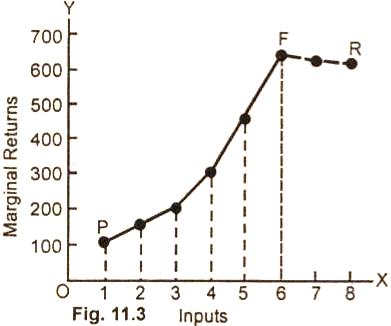Law of Increasing Returns/Law
of Diminishing Cost:
(Version of Classical and Neo
Classical Economists):
Definition and Explanation:
The law of increasing returns
is also called the law of diminishing costs. The law of
increasing return states that:
"When more and more units of a
variable factor is employed, while other factor remain fixed,
there is an increase of production at a higher rate. The
tendency of the marginal return to rise per unit of variable
factors employed in fixed amounts of other factors by a firm is
called the law of increasing return".
An increase of variable factor,
holding constant the quantity of other factors, leads generally
to improved organization. The output increases
at a rate higher than the rate of increase in the employment of
variable factor.
The increase in output faster than
inputs continues so long as there is not deficiency of an
essential factor in the process of production. As soon as there
occurs shortage or a wrong or defective combination in
productive process, the marginal product begins to decline. The
law of diminishing return begins to operate. We can, therefore,
say that there are no separate laws applicable to agriculture
and to industries. It is only the law of variable proportions
which applies to a!! the different industries. However, the
duration of stages in each productive undertaking will vary.
They will depend upon the availability of resources, their
combination in right proportions, etc., etc.
Application of the Law of Increasing
Returns in Industries:
There are certain manufacturing
industries where the factors of production can be combined and
substituted up to a certain limit, it is the law of increasing
returns which operates. In the words of Prof. Chapman:
"The expansion of an industry in
which there is no dearth of necessary agents of production tends
to be accompanied, other things being equal, by increasing
returns".
The increasing returns mainly arises
from the fact that large scale production is able to secure certain economies of
production, both internal and external. When an industry is
expanded, it reaps advantages of division of labor, specialized
machinery, commercial advantages, buying and selling wholesale,
economies in overhead expenses, utilization of by products, use
of extensive publicity and advertisement, availability of cheap
credit, etc.. etc.
The law of increasing returns also
operates so long as a factor consists of large indivisible units
and the plant is producing below its capacity. In that case,
every additional investment will result in the increase of
marginal productivity and so in lowering the cost of production
of the commodity produced. The increase in the marginal
productivity continues till the plant begins to produce to its
full capacity.
Assumptions:
The law rests upon the following
assumptions:
(i) There is a scope in the
improvement of technique of production.
(ii) At least one factor of
production is assumed to be indivisible.
(iii) Some factors are supposed to
be divisible.
Example:
The law of increasing returns can
also be explained with the help of a schedule and a curve.
Schedule:
|
Inputs |
Total
Returns (meters of cloth)
|
Marginal
Returns
(meters of cloth)
|
|
1
|
100
|
100
|
|
2
|
250
|
150
|
|
3
|
450
|
200 |
|
4
|
750
|
300
|
|
5
|
1200
|
450
|
|
6
|
1850
|
650
|
|
7 |
2455 |
605
|
|
8
|
3045
|
600
|
In the above table it is dear that
as the manufacturer goes on expanding his business by investing
successive units of inputs, the marginal return goes on
increasing up to the 6th unit and then it beings to decline
steadily, Here, a question ca be asked as to why the law of
diminishing returns has operated in an industry?
The answer is very simple. The
marginal returns has diminished after the sixth unit because of
the non-availability of a factor or factors of production or.
the size of the business has become so large that it has become unwieldy to manage it, or
the plant is producing to its full capacity and it is not
possible further to reap the economies of large scale
production, etc., etc.
Diagram/Graph:

In figure 11.3, along OX axis are
measured the units of inputs applied and along OY axis the
marginal return is represented. PF is the curve representing the
law of increasing returns.
Compatibility of Diminishing and Increasing Returns:
It is often pointed out by the
classical economists that the law of diminishing returns is
exclusively confined to agriculture and other extractive
industries, such as mining fisheries, etc. while manufacturing
industries obey the law of increasing returns. In the words of
Marshall:
"While the part which Nature plays
in production shows a tendency to diminishing returns and the
part which man plays shows a tendency to increasing returns".
The modern economists differ with
this view and are of the opinion that the law of diminishing
returns applies both to agriculture and the industry. The only
difference is that in agriculture the law of diminishing returns
begins to operate at an early stage and in an industry somewhere
at a later stage.
The law of increasing returns is
also named as the Law of Diminishing Cost. When the addition to
output becomes larger, as the firm adds successive units of a
variable input to some fixed inputs, the per unit cost begins to
decline. The tendency of the cost per unit to decline with
increased application of a variable factor to fixed factors is
called the Law of Diminishing Cost.
Relevant Articles:
|